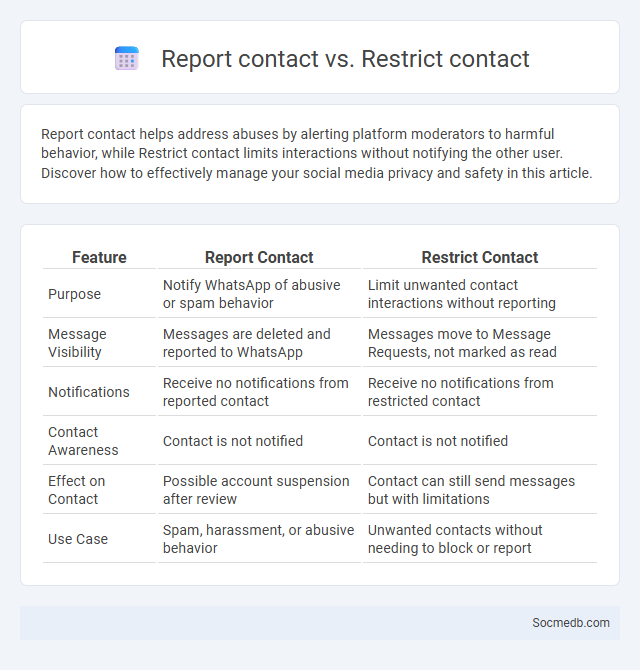
Photo illustration: Report contact vs Restrict contact
Report contact helps address abuses by alerting platform moderators to harmful behavior, while Restrict contact limits interactions without notifying the other user. Discover how to effectively manage your social media privacy and safety in this article.
Table of Comparison
| Feature | Report Contact | Restrict Contact |
|---|---|---|
| Purpose | Notify WhatsApp of abusive or spam behavior | Limit unwanted contact interactions without reporting |
| Message Visibility | Messages are deleted and reported to WhatsApp | Messages move to Message Requests, not marked as read |
| Notifications | Receive no notifications from reported contact | Receive no notifications from restricted contact |
| Contact Awareness | Contact is not notified | Contact is not notified |
| Effect on Contact | Possible account suspension after review | Contact can still send messages but with limitations |
| Use Case | Spam, harassment, or abusive behavior | Unwanted contacts without needing to block or report |
Understanding Report Contact: Definition and Use Cases
Understanding report contact in social media involves recognizing a dedicated channel through which users can flag inappropriate or harmful content. This feature enables platforms to gather specific information about issues such as harassment, spam, or misinformation to protect community standards. Its use cases include reporting abusive behavior, intellectual property violations, and account impersonation to maintain a safer online environment.
What Does Restrict Contact Mean?
Restrict contact on social media means limiting interactions with specific users without fully blocking them, preventing them from seeing your posts or contacting you directly. Your restricted users can still comment or send messages, but their activity is less visible to you and your followers. This feature enhances privacy and control over your online presence without causing potential conflict.
Key Differences Between Reporting and Restricting Contacts
Reporting contacts on social media involves notifying the platform about abusive, spammy, or inappropriate behavior, triggering investigations and potential account penalties based on community guidelines violations. Restricting contacts limits interactions with specific users without alerting them, controlling visibility of posts and direct messages to prevent unwanted communication discreetly. Understanding these key differences helps users effectively manage their online safety and privacy through appropriate platform tools.
When Should You Report a Contact?
Report a contact on social media when they engage in harmful behaviors such as harassment, hate speech, threats, or the spread of misinformation that violates platform policies. Immediate reporting is crucial if the content involves cyberbullying, explicit material, or any form of illegal activity to protect yourself and others. Timely action helps social media platforms enforce community guidelines and maintain a safer online environment.
When Is Restricting a Contact More Appropriate?
Restricting a contact on social media is more appropriate when you want to limit their interaction without fully blocking them, such as preventing them from seeing your posts or commenting publicly. This option helps maintain privacy and control over your online presence while avoiding potential social conflict. It is especially useful for managing uncomfortable interactions or reducing harassment without severing the connection entirely.
Step-by-Step Guide: How to Report a Contact
To report a contact on social media, locate their profile and find the options menu, typically represented by three dots or a gear icon. Select "Report" and choose the appropriate reason, such as harassment, spam, or impersonation, to ensure accurate processing. Submit the report, and most platforms will review it according to their community guidelines, often providing follow-up notifications on the status.
Step-by-Step Guide: How to Restrict a Contact
To restrict a contact on social media, navigate to the profile of the person you want to limit and locate the settings or options menu, typically represented by three dots or a gear icon. Select the "Restrict" option to limit their interaction without fully blocking them, reducing their visibility on your posts and messages. Your privacy improves as this feature allows you to control who can see your content while maintaining a low-profile interaction with restricted contacts.
Pros and Cons of Reporting vs. Restricting Contacts
Reporting contacts on social media helps protect your online safety by alerting platforms to harmful behavior and potentially preventing abuse or harassment. Restricting contacts limits interactions without notifying the offending party, offering a more discreet way to manage your social environment but potentially allowing harmful behavior to persist. Balancing between reporting and restricting depends on your need for privacy and the severity of the contact's actions.
Privacy and Safety Implications: Report vs. Restrict
Social media platforms face ongoing challenges balancing privacy and safety, with reports of harmful content prompting user action versus algorithmic restrictions implemented by companies. Reporting empowers users to flag content threatening individual well-being or violating community standards, promoting a grassroots safety mechanism. Restricting harmful posts through automated filters and policies aims to prevent widespread exposure but raises concerns about censorship and privacy boundaries.
Choosing the Best Action for Managing Unwanted Contacts
Selecting the best action for managing unwanted contacts on social media involves utilizing privacy settings to block or restrict users, reporting abusive behavior to platform moderators, and customizing friend lists to control content visibility. Effective use of built-in tools like blocking, muting, and reporting helps maintain a secure online environment and prevents harassment or spam. Regularly reviewing follower lists and adjusting permissions is essential for proactive social media management and safeguarding personal information.
 socmedb.com
socmedb.com